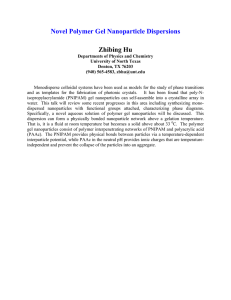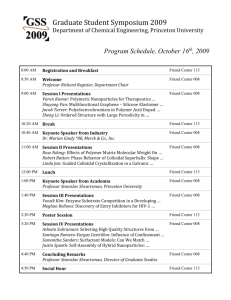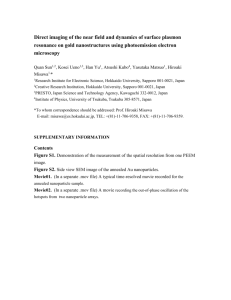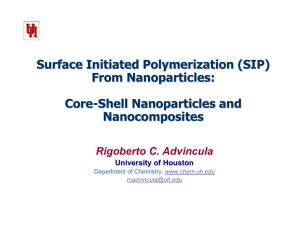Template for Electronic Submission to ACS Journals
advertisement
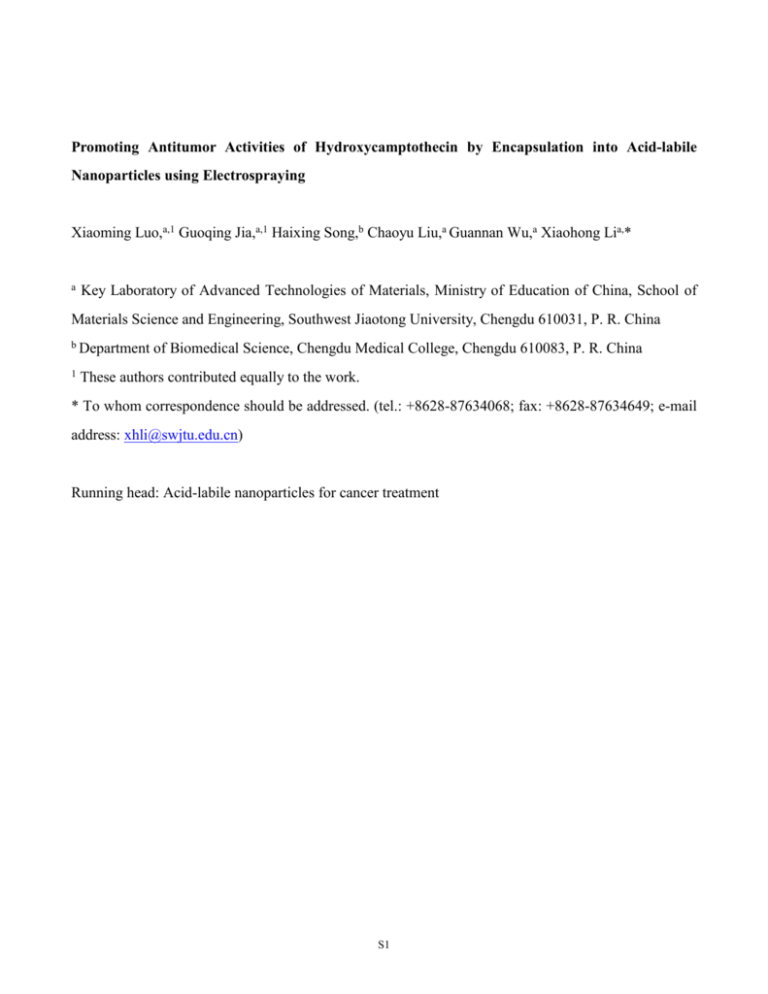
Promoting Antitumor Activities of Hydroxycamptothecin by Encapsulation into Acid-labile Nanoparticles using Electrospraying Xiaoming Luo,a,1 Guoqing Jia,a,1 Haixing Song,b Chaoyu Liu,a Guannan Wu,a Xiaohong Lia,* a Key Laboratory of Advanced Technologies of Materials, Ministry of Education of China, School of Materials Science and Engineering, Southwest Jiaotong University, Chengdu 610031, P. R. China b Department 1 of Biomedical Science, Chengdu Medical College, Chengdu 610083, P. R. China These authors contributed equally to the work. * To whom correspondence should be addressed. (tel.: +8628-87634068; fax: +8628-87634649; e-mail address: xhli@swjtu.edu.cn) Running head: Acid-labile nanoparticles for cancer treatment S1 Supplementary Material Electrospraying has been experimentally demonstrated as a viable process for generating micro- or nanometer particles. Enayati et al. and Jaworek provided details on the background of the electrospraying process and the effect of process parameters on the characteristics of electrosprayed nanoparticles (1, 2). In the current study, a grounded copper foil immersed in water and ethanol (1/1, v/v) was used to collect electrosprayed nanoparticles instead of the commonly used steel plate or aluminum-foil. Therefore, to quantitatively evaluate and statistically analyze the effects of solution properties and processing parameters on the nanoparticle properties, an orthogonal experimental design was applied (3). The concentration and flow velocity of polymer solution, and the nozzle size were selected as the test factors, and three levels were set for each factor. The concentrations of polymer solutions were set at 3.0%, 5.0% and 7.0%, the flow velocities were 2.0, 3.0 and 4.0 ml/h, and the nozzle sizes were 0.45, 0.55 and 0.60 mm. The orthogonal table L9(3)4 was designed, in which a blank column was designated for error evaluation. The electrospraying process was set up as mentioned in the main text, and the particle size was measured by a Nano-ZS laser particle analyzer (Zetasizer Nano ZS, Malvern Co., UK). Table S1 summarizes the orthogonal table and the sizes of electrosprayed nanoparticles. A range analysis was aimed to clarify the significance levels of different factors that may have effects on the nanoparticle size. Those most significant factors could also be disclosed basing on the results of range analysis. Table S1 summarizes the statistics analysis of the effect of different factors on the diameters of electrosprayed nanoparticles. The K value for each level of a parameter was the average of six values shown in Table S1, and the range value (R) for each factor was the difference between the maximal and minimal values of three levels. As shown in Table S1, the significance sequence of all the investigated factors was lined as follows: polymer concentration, nozzle size, and flow rate. Statistics software of SPSS 12.0 was used for the regressive analysis. The polymer concentration (X1, %) and nozzle size (X2, mm) were set as variables, and the dependent variable was the nanoparticle size (Y, nm). The linear dependence regression equation was: Y=113.0+14.92X1+95.2X2 (R2=0.931) S2 The correlation coefficients of the regression analysis were relatively high, which was in agreement with the requirements of statistic analysis. It was suggested that the solution concentration and nozzle size had regular effects on the nanoparticle size. Table S1. Design of orthogonal Table L9(3)4 and the sizes of electrosprayed nanoparticles. Polymer conc. Flow rate Nozzle size Size (%) (ml/h) (mm) (nm) 1 3.0 2.0 0.45 201 2 3.0 3.0 0.55 217 3 3.0 4.0 0.60 221 4 5.0 3.0 0.60 263 5 5.0 4.0 0.45 243 6 5.0 2.0 0.55 250 7 7.0 4.0 0.55 275 8 7.0 2.0 0.60 273 9 7.0 3.0 0.45 270 K1 213.0 241.3 238.0 K2 252.0 250.0 247.3 K3 272.7 246.3 252.3 R 59.7 8.67 14.3 Exp. No. To validate the results of the regression analysis, several batches of drug-loaded nanoparticles were prepared to clarify the differences between the predicted and experimental values. Table S2 summarizes the results, indicating a good agreement of the observed values with the predicted ones. When the regression equation was set up for the electrospraying system, nanoparticles with a certain range of diameter can be obtained through designing the process parameters. Thus, the optimization of process parameters would be greatly simplified, which was essential for the scale-up of electrospraying system to meet wide applications. S3 Table S2. Validation tests of the orthogonal experimental analysis Polymer Conc. Nozzle size Flow rate (%) (mm) (ml/h) Batch No. Average size (nm) Cal. Exp. 1 2.0 0.45 3.0 193 213 2 5.0 0.55 2.0 255 268 3 7.0 0.55 4.0 287 272 4 10.0 0.45 4.0 323 356 5 3.0 0.55 3.0 233 252 References 1. Enayati M, Chang MW, Bragman F, Edirisinghe M, Stride E. Electrohydrodynamic preparation of particles, capsules and bubbles for biomedical engineering applications. Colloids Surf A. 2011;382:15464. 2. Jaworek A. Micro- and nanoparticle production by electrospraying. Powder Technol. 2007;176:1835. 3. Cui WG, Li XH, Zhou SB, Weng J. Investigation on process parameters of electrospinning system through orthogonal experimental design. J Appl Polym Sci. 2007;103:310512. S4

